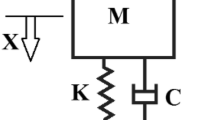Abstract
As audio-visual electronic devices such as TV and laptop computer get thinner, vibrations due to speakers bring about sometimes deteriorations in the audio-visual performance. When visco-elastic isolators are installed between speakers and device structures in order to reduce the structural vibration just based on the transmissibility of a single-degree of freedom system, other by-product problems may occur, such as the structural vibration noise inside the devices or the decrease of read/write speed in a hard disk drive system. In this paper, how to isolate speakers is presented so as to reduce the structural vibration of audio-visual electronic devices without reducing the vibration of the cone in speakers. An electro-mechanical vibration model for the whole system, which includes a loud speaker, vibration isolators and a device structure, is derived based on the substructure synthesis method. A dynamic model is derived mathematically for the loud speaker, isolators are treated as lumped springs and damping elements and the device structure is characterized experimentally in terms of compliance. Subsequently, they are coupled using frequency response functions at the connection points. It is claimed that, through simulations on modification of the isolator stiffness and loss factor, a realistically ‘good’ isolator can be designed before making a prototype so that the vibration of the structure may be the minimum, yet without reducing the key performance of a loud speaker in terms of vibration of speaker cone.
Similar content being viewed by others
References
I.-H. Cha, Acoustics, Han-Shin (1976).
S.-J. Oh, Fundamentals of loudspeaker engineering, Seok-Hak (2006).
D. J. Ewins, Modal testing 2, Research studies press (2000).
C. W. de Silva, Vibration (Fundamentals and practice) 2 nd edition, Taylor & Francis (2007).
Author information
Authors and Affiliations
Corresponding author
Additional information
This paper was recommended for publication in revised form by Associate Editor Ohseop Song
Jong-Oh Sun received his B.S. degree in mechanical engineering from Han-Yang University in 2006 and M.S. degree from KAIST in 2007. He is currently a Ph.D. candidate in KAIST and his research interests are in passive and active vibration control.
Kwang-joon Kim received B.S. and M.S. degrees from Seoul National University in 1976 and 1978. He also received Ph.D. degree from the University of Wisconsin -Madison. He is currently a full professor in department of mechanical engineering at KAIST. His research interests are in application of viscoelastic materials for vibration control, experimental approach in dynamics of transportation systems, vibration isolation based on power transmission approach, input identification, modal testing, operational deflection shape analysis, etc.
Rights and permissions
About this article
Cite this article
Sun, JO., Kim, Kj. Isolation of vibrations due to speakers in audio-visual electronic devices without deteriorating vibration of speaker cone. J Mech Sci Technol 26, 723–730 (2012). https://doi.org/10.1007/s12206-011-1227-9
Received:
Revised:
Accepted:
Published:
Issue Date:
DOI: https://doi.org/10.1007/s12206-011-1227-9




